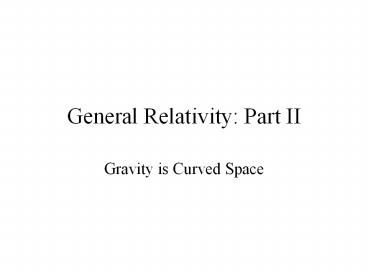General Relativity: Part II - PowerPoint PPT Presentation
1 / 28
Title:
General Relativity: Part II
Description:
Title: PowerPoint Presentation Last modified by: Roberta Tevlin Created Date: 1/1/1601 12:00:00 AM Document presentation format: On-screen Show (4:3) – PowerPoint PPT presentation
Number of Views:39
Avg rating:3.0/5.0
Title: General Relativity: Part II
1
General Relativity Part II
- Gravity is Curved Space
2
- 1) You walk 10 km south, 10 km west and then 10
km north and you are back where you started. - What colour is the bear?
- a) brown b) black c) white
Hint There is only one place in the world where
this would happen.
3
- We live in a 4-dimensional curved space which we
cannot see or experience directly. - We can get a sense of how it works by using an
analogy with fewer dimensions.
4
- Imagine that you are a smart blind ant moving
about on the surface of a balloon. Draw the path
of the polar explorer from the the riddle on your
balloon.
5
- 2) Suppose that there is a light at the North
Pole. The light radiates in all directions and
follows the straightest lines in this space. What
will an ant at the South Pole notice? - a) Nothing.
- b) A bright spot.
- c) A bright ring.
6
The curved arcs that you see in this photograph
are coming from a distant light. Between it and
the Earth there is a large mass that warps the
space, so that light appears to come from many
directions.
7
- We can detect how mass distorts the three
dimensions of space but we cant picture it.
4) How would an ant explain this motion?
8
- When Einstein first calculated the curvature of
light he got it wrong by a factor of two. Half
the curvature is from the equivalence principle
and the second half is from the curvature of
space.
9
- Mass curves spacetime into gravitational lenses.
10
- Gravitational lenses are used by astronomers to
measure the mass of regular matter and dark
matter.
11
- Draw a 15-cm line on your balloon. At right
angles to that, draw another 15-cm line. Draw two
more of them. What do you get?
12
- Planetary orbits dont form simple ellipses
either. They form patterns like Daisy petals -
this is called the precession of the equinoxes.
This was a known problem with Newtonian
Gravitation that General Relativity was able to
solve.
13
- 5) The planet with the greatest precession will
be - a) Jupiter because it is biggest
- b) Mercury because it is smallest
- c) Mercury because it is closest to the
sun - d) Neptune because it is farthest
14
- Suppose, the balloon was expanding.
- What would the ant notice?
15
The galaxies are all moving away from us and the
more distant ones are moving faster.
16
- There is a simple relationship between velocity
and distance. This suggests that everything in
the universe was once gathered in one point that
exploded around 14 billion years ago the Big
Bang.
17
- 6) Gravity should cause this expansion to
- a) slow down b) speed up c) remain constant.
Best-fit
Constant velocity
18
- 7)As a stars life ends, it collapses and gets
much denser. What would you see if you got close
to dense star whose escape velocity was almost c? - a) Light rising and falling
- b) Faint radio waves
- c) Faint gamma rays
19
- 8) What happens if the escape velocity is
greater than c? - a) only gamma rays escape
- b) only radio waves escape
- c) nothing escapes
- d) nothing escapes so it cant be detected
20
- You can detect one by the way it warps light.
21
- You can detect black holes that have matter
spiraling into them. This matter will form hot
disks that give off x-rays.
22
- Black Holes often produce jets spewing matter
out at speeds close to c. Many of these have been
found.
23
Black holes can also be detected by measuring
the speeds of orbiting bodies. This data can be
used to calculate the mass and density of the
central body.
M v2 r /G
24
- What is it like inside a Black Hole? All light
and matter will be driven by the extremely curved
spacetime into a singularity of infinite density.
25
- Rapidly orbiting massive objects should generate
gravitational waves, ripples in the fabric of
space. - These waves take energy away, so the objects
should spiral into the center.
26
- Taylor and Hulse have measured a binary pulsar
doing exactly that.
27
- Large detectors are being built around the world
to detect gravitational waves directly. - This is LIGO.
28
- An even larger gravity detector called LISA, is
being built. It is made of three satellites in a
huge triangle. It may be able to measure the
curvature near a Black Hole.































